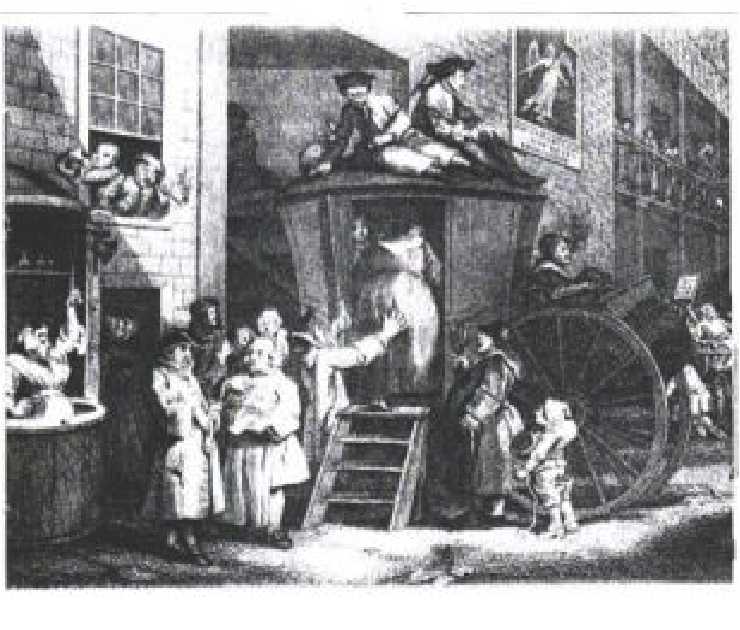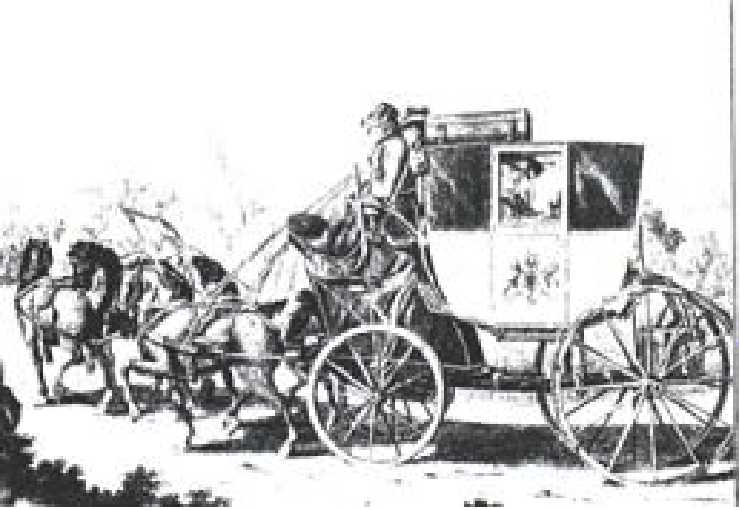|
TRAVEL IN WALES (continued)
Contents of this section
Travelling Preachers and
Teachers
The Canals
Coach Travel
Travelling Preachers
and Teachers
Education was woefully lacking at this period. Children were needed to earn money
or support the parents by working in the fields. Schools for the children of a few
parishes were set up in the seventeenth century, attached to the churches, which
helped to maintain them in part from the tithes.
The curriculum was mostly devoted to reading, writing and arithmetic, some Latin
but no Welsh. This project came to an end in 1660. Thomas Gouge was an ejected preacher
from Southwark in London. In 1671 he went on an illegal preaching tour in Wales and
was profoundly impressed by the illiteracy and destitution of the people. Through
his subsequent efforts a Welsh Trust was set up, along with other Puritans such as
Stephen Hughes. Hughes was a man who had translated the Catechism and the book of
Psalms and the Book of Common Prayer into Welsh. Through the auspices and financial
patronage of the Lord Mayor of London the Welsh Trust was able to publish and distribute
a number of suitable books in Welsh. Although the Trust lasted only a short time,
soon a new body was formed. This was to be the start of the Society for the Promotion
of Christian Knowledge (the S.P.C.K.) The S.P.C.K was seriously hampered by a shortage
of teachers for the schools that it wished to promote.
A number of schools were started, but because the teaching was in English to Welsh
speaking pupils, once again the good intentions were frustrated. However one Welshman
came to be known for his efforts in overcoming this overwhelming problem.
He was Gruffydd Jones, who from humble beginnings as a parish priest, set in motion
the most important educational movement of the 18th century, the circulating schools.
Gruffydd Jones was a realist; he knew that the children would not be available in
the summer months to attend school when their labour would be needed in the fields.
Hence three monthly courses were organised from September to May. The teachers so
employed would stay for three or four months in one place and then move on to another
district where a church room or other accommodation could be found. Sadly Gruffydd
Jones died in 1761. Although Bridget Beavan maintained the schools, Jones's patron,
her support came to an end when Bridget died 18 years later, in which year there
were 243 schools in being.
During the uprising of non-conformatism in the 18th century when the Church of England
was at a low ebb in Wales, the preachers who had found inspiration in the giving
of sermons in the open air, were sometimes rebuked and persecuted by the clergy who
became less part of Christian worship in Wales.
Men like Howell Harris, Daniel Rowland and William Williams of Pantycelyn inspired
each other and sought education in schools like Llwyn Llwyd near Hay in Brecknockshire.
It is said that Howell Harris travelled 30,000 miles, preaching where he could command
a congregation from 1738, (when he was 24,) till 1743. Driven on by his mission in
life, he sometimes fell asleep on the way and dropped from his horse from fatigue.
Massive social and economic change began around 1780 when the rise of iron smelting
and the need for coal brought about the great smelting works in Merthyr Tydful of
people like Crawshay and Guest. This caused a vast influx of migrant workers not
only native Welshmen but also Irish and English incomers. The population of Wales
according to the first population census of 1801 was 587,000 and rose by 1851 to
1,163,000.
In Merthyr there were 7000 inhabitants in 1801 but by 1851 there were 64,000. The
most densely populated town in Wales.
In the once picturesque valley of the Rhondda pits were dug to mine coal. In turn
miners housing was built close to the works; rows of mean and squalid terraced houses
sprawled up and down the valleys.
for more information on Welsh Schools,
please click
here
back to the
top
The Canals
 The advent of industrialisation in Wales meant
that there was great demand to move the products of the iron works and the coal mines.
People like Richard Crawshay, Thomas Guest, Francis Homfray and Richard Hill were
rivals competing with one another but when it came to schemes like the Glamorganshire
Canal they would co-operate to their mutual benefit. A bill promoted by the iron
masters was presented to Parliament in 1790 to allow the building of the Glamorganshire
Canal. Building of canals was progressing all over Great Britain at this period at
the turn of the 18th century. From its inception in 1794 the Glamorganshire Canal
and its associated tram roads enabled the four companies to ship their produce away.
It was a remarkable engineering achievement involving cutting through a narrow twisting
valley and the building of forty locks from the ironworks to the sea. The advent of industrialisation in Wales meant
that there was great demand to move the products of the iron works and the coal mines.
People like Richard Crawshay, Thomas Guest, Francis Homfray and Richard Hill were
rivals competing with one another but when it came to schemes like the Glamorganshire
Canal they would co-operate to their mutual benefit. A bill promoted by the iron
masters was presented to Parliament in 1790 to allow the building of the Glamorganshire
Canal. Building of canals was progressing all over Great Britain at this period at
the turn of the 18th century. From its inception in 1794 the Glamorganshire Canal
and its associated tram roads enabled the four companies to ship their produce away.
It was a remarkable engineering achievement involving cutting through a narrow twisting
valley and the building of forty locks from the ironworks to the sea.
In 1820 a total of 49,000 was carried rising to 133,000 tons by 1839. Though slow
and cumbersome the barges would not be quickly replaced by railway transport. Still
the traveller who had journeys to make, rode his horse, or climbed aboard one of
the many stagecoaches that made uncomfortable and often perilous journeys from place
to place.
back to the
top
Coach Travel
As has been said travelling was an undertaking not to be undertaken lightly.
The roads were in especially poor repair and highwaymen could beset the poorly defended
passengers. Even so, the way  bills an advertisements
promised speedy travel from centre to centre. bills an advertisements
promised speedy travel from centre to centre.
Typical time tables gave stopping times from towns like Brecon to London accomplishing
the 250 miles or so in less than a day. At a cost of around 5p per mile, speeds of
eight to ten miles per hour were achieved.
It would seem that the crossing from Ireland to Milford Haven would result afterwards
in a journey by stagecoach of some 34 hours to London. The ferry crossing of the
Severn by way of the New Passage was reckoned to take an hour. The boat would embark
the passengers from the Welsh side and land them on the opposite bank of the Severn
near the English Stones, a trip in itself fraught with dangers in bad and tempestuous
weather.
In 1830 the distance between London and Milford Haven was officially given as 256
1/2 miles via Gloucester and Brecon and 273 1/4 miles via Bristol and Cardiff, The
respective journeys taking 33 hrs and 34 1/4 hrs. The Old Passage was a ferry crossing
a few miles upstream between Aust and Beachley. The Welsh Mail however was routed
through the New Passage ferry across the Severn; a half a mile to the east of the
course now followed by the Severn rail tunnel. An hour was allowed for the three
mile passage across but often the perilous trip could take four or five hours.
There were sand banks and gravel banks to be avoided and, worst of all the sullen
mass of rocks known as the English Stones, which stretched more than half way across
the channel.
 The first mail coaches from London to Milford crossed
the Severn in 1785 by way of the New Passage, where a ferry had been reopened in
1718, after more than half a century of disuse. The first mail coaches from London to Milford crossed
the Severn in 1785 by way of the New Passage, where a ferry had been reopened in
1718, after more than half a century of disuse.
In May 1825 an article appeared in the 'Cambrian' headed 'Important improvements
to the Old Passage Ferry'. Henry H.Price, a civil engineer from Neath Abbey, with
the intention of building a causeway and piers at the ferry point, undertook a survey.
When complete this would allow passengers and freight dry access to the water's edge,
in all states of the tide; and small steamboat of 12 HP, will cross every 1/4 hr.
The crossing would take between 10 and 20 mins. According to the state of the wind
and tides. Platforms and stages for the convenient shipment of horses and carriages
will be attached, and two large boats, to be towed by the steamer, will be constantly
in attendance. The foundation stone was laid in March 1826. The steamer began crossing
on 13 June 1826 a little later than planned, but ten days later the 'Cambrian' reported
'it has already transported several thousand passengers and many hundreds of horses
and carriages'.
Charges were listed as:
1/- for after cabin passengers (or 1/6 return to and fro the same day)
12/- for a coach, landau, post-chaise or other heavy four-wheel carriage.
Other tolls were listed as:
4/- for a two-wheeled carriage.
5/6 for a cart - 10/- for a waggon.
£1 for a mourning coach or hearse.
1/- for a horse, 6d ea cattle, 2d dogs, pigs, sheep and calves.
Tolls were doubled before sunrise or later than one hour after sunset.
back to the
top
|